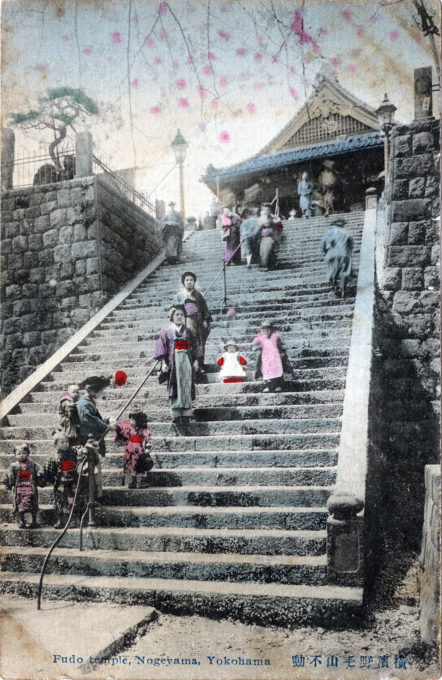“A little way down the Daijingu hill is a temple dedicated to an Indian deity, Fudo. The place is crowded by devotees on the 28th of every month when a regular festival takes place at the temple.
“At the left of the steps leading to the temple is a sword-shaped monument erected to the memory those Yokohama soldiers and sailors who fell in the Japan-China war of 1894-95. On the monument are inscribed the names of those who were killed in the campaign and it is lighted by electricity at night.”
– Guide Book for Tourists in Japan, by Charles W. Wason, 1898
See also:
Sankeiyen, Yokohama, c. 1920.
Engakuji Temple, Kamakura, c. 1940.
“Presently we reach a narrow and densely wooded gully descending straight down the face of the Bluff, and we perceive two flights of stone steps ascending beside it for about one hundred feet to a small temple nestling close under the summit of the Bluff.
“One flight of steps goes up straight and steep, the men’s ascent; the other follows a more winding course, with a gentler gradient, and is for women. Reaching the little temple we find that it has been built beside the spot where the little stream which made the gully leaps from its narrow bed as a waterfall. Beneath this pilgrims stand as a penance, or at any rate as an observance.
“The stream, where it comes from the cliff, has been made to issue from the mouth of a fierce stone dragon. I often visited this little temple, dedicated to Fudo, the god, or the idea, of ‘the impregnability of perfect enlightenment against which the passions cannot prevail.’
“I generally approached it from the plateau, which I crossed from the Bluff Hotel, exposed to the raw cold winds which prevailed during the first weeks of our stay. Thence one dropped suddenly into the sheltered nook where the little temple stands, finding shelter and warmth, and an arbour from which to enjoy a lovely view over Mississippi Bay.
“The view, perhaps equally with the waterfall, is a reason for the erection of a temple here, for a Japanese almost worships scenery. I think I do also, and the place came to have for me something of the significance of ‘Fudo’ before I had learnt to whom the temple was dedicated, or what Fudo typified.
“The little temple was evidently but poorly endowed, probably owing to the absence of a cemetery, being more like a hermit’s chapel than a parish church. The hermit, however, was married, and his wife was priestess, and wore her hair unkempt. I photographed her in her little temple with its big drum, and she used to give me tea while I enjoyed the view of the bay.”
– The Travels of Ellen Cornish: Being the Memoir of a Pilgrim of Science, by Vaughn Cornish, 1913


